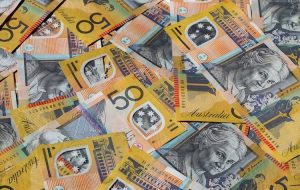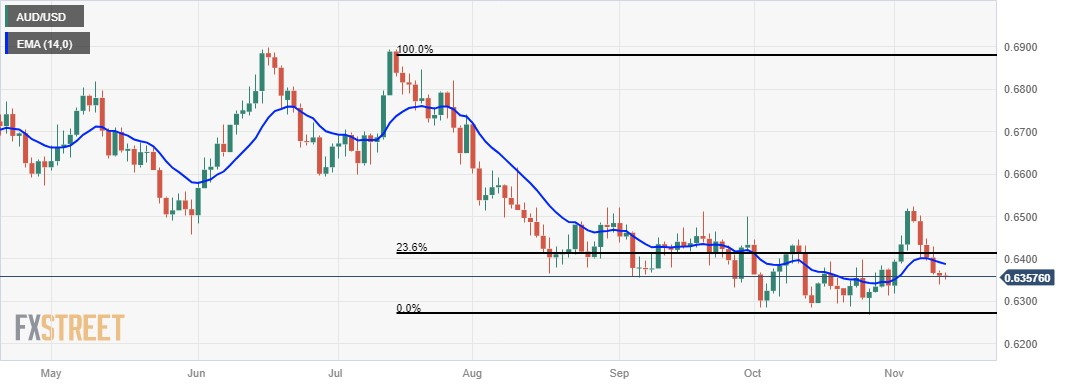Australian Dollar moves around a major level with a negative bias
[ad_1] Share: Australian Dollar could continue its downward trajectory. Australia’s central bank adopted a dovish stance in their recent meeting. US Dollar seems lukewarm, despite the positive tone of US bond yields. The Australian Dollar (AUD) aims to continue a week-long slump while the US Dollar (USD) keeps weakening on Monday despite higher US

[ad_1]
- Australian Dollar could continue its downward trajectory.
- Australia’s central bank adopted a dovish stance in their recent meeting.
- US Dollar seems lukewarm, despite the positive tone of US bond yields.
The Australian Dollar (AUD) aims to continue a week-long slump while the US Dollar (USD) keeps weakening on Monday despite higher US Treasury yields. However, the AUD/USD pair feels the squeeze after the Reserve Bank of Australia (RBA) struck a dovish chord in their recent meeting.
Australia’s central bank issued its Monetary Policy Statement (MPS) on Friday, indicating the hurdles posed by stubborn inflation and a sluggish Australian economy. The RBA has its sights set on realigning inflation with its target. After careful consideration, the idea of hitting the pause button was on the table in November, but the RBA leaned towards the confidence of a rate hike as a more effective measure to tackle inflation concerns.
Federal Reserve (Fed) Chair Jerome Powell surprised in his speech on Thursday, taking a more hawkish stance than anticipated. Powell expressed concerns that the current policies might not be restrictive enough to reel inflation to the coveted 2.0% target. However, the market vibe suggests a widespread belief that the Fed has wrapped up its tightening cycle.
However, on Friday, the Greenback faces a challenge after the preliminary US Michigan Consumer Sentiment data for November showed a dip in the mood among consumers in the United States (US). It fell to 60.4 from 63.8 in the previous month.
Daily Digest Market Movers: Australian Dollar moves sideways, looks for fresh impetus
- RBA increased the Official Cash Rate (OCR) from 4.10% to a 12-year high of 4.35%, responding to the latest Monthly Consumer Price Index (YoY) for September, which indicated a notable increase of 5.6% compared to the expected 5.4% growth.
- Australia’s TD Securities Inflation (YoY) eased at 5.1% in September from 5.7% prior.
- Australia’s Retail Sales grew 0.2% in the third quarter after contracting by 0.6% in the previous quarter.
- Economists at the National Australia Bank (NAB) anticipate another 25 basis points hike in February following the Q4 inflation data. Additionally, NAB believes rate cuts will unlikely commence until November 2024.
- China’s Consumer Price Index (CPI) witnessed an annual decline of 0.2% in October, compared to the expected 0.1% decrease. The monthly CPI dropped by 0.1%, contrasting with the earlier 0.2% growth. A weaker economic scenario in China casts a shadow over the Aussie Dollar (AUD), given Australia’s heavy reliance on its largest trading partner.
- US weekly Initial Jobless Claims for the week ending November 4 totaled 217K, slightly below the market forecast of 218K and the previous week’s figure of 220K.
Technical Analysis: Australian Dollar hovers around 0.6350 with a negative tone
The Australian Dollar walks on a tightrope above the crucial support level of 0.6350 on Monday. A decisive break below might set the AUD/USD pair on a downward journey, eyeing the previous two-week low at 0.6314. On the flip side, the 14-day Exponential Moving Average (EMA) at 0.6387 poses as the initial resistance, followed by the 23.6% Fibonacci retracement at 0.6413, and the psychological hurdle at 0.6500.
AUD/USD: Daily Chart

Australian Dollar price today
The table below shows the percentage change of Australian Dollar (AUD) against listed major currencies today. Australian Dollar was the weakest against the Pound Sterling.
| USD | EUR | GBP | CAD | AUD | JPY | NZD | CHF | |
| USD | 0.06% | -0.02% | 0.09% | 0.09% | 0.09% | 0.08% | 0.04% | |
| EUR | -0.06% | -0.06% | 0.03% | 0.05% | 0.03% | 0.03% | -0.02% | |
| GBP | 0.01% | 0.06% | 0.09% | 0.11% | 0.09% | 0.09% | 0.04% | |
| CAD | -0.09% | -0.03% | -0.09% | 0.02% | 0.00% | 0.00% | -0.05% | |
| AUD | -0.09% | -0.05% | -0.11% | -0.02% | -0.02% | -0.01% | -0.06% | |
| JPY | -0.09% | -0.03% | -0.09% | -0.01% | 0.02% | 0.00% | -0.05% | |
| NZD | -0.08% | -0.03% | -0.11% | 0.00% | 0.01% | 0.01% | -0.05% | |
| CHF | -0.04% | 0.02% | -0.04% | 0.05% | 0.07% | 0.05% | 0.05% |
The heat map shows percentage changes of major currencies against each other. The base currency is picked from the left column, while the quote currency is picked from the top row. For example, if you pick the Euro from the left column and move along the horizontal line to the Japanese Yen, the percentage change displayed in the box will represent EUR (base)/JPY (quote).
Australian Dollar FAQs
One of the most significant factors for the Australian Dollar (AUD) is the level of interest rates set by the Reserve Bank of Australia (RBA). Because Australia is a resource-rich country another key driver is the price of its biggest export, Iron Ore. The health of the Chinese economy, its largest trading partner, is a factor, as well as inflation in Australia, its growth rate and Trade Balance. Market sentiment – whether investors are taking on more risky assets (risk-on) or seeking safe-havens (risk-off) – is also a factor, with risk-on positive for AUD.
The Reserve Bank of Australia (RBA) influences the Australian Dollar (AUD) by setting the level of interest rates that Australian banks can lend to each other. This influences the level of interest rates in the economy as a whole. The main goal of the RBA is to maintain a stable inflation rate of 2-3% by adjusting interest rates up or down. Relatively high interest rates compared to other major central banks support the AUD, and the opposite for relatively low. The RBA can also use quantitative easing and tightening to influence credit conditions, with the former AUD-negative and the latter AUD-positive.
China is Australia’s largest trading partner so the health of the Chinese economy is a major influence on the value of the Australian Dollar (AUD). When the Chinese economy is doing well it purchases more raw materials, goods and services from Australia, lifting demand for the AUD, and pushing up its value. The opposite is the case when the Chinese economy is not growing as fast as expected. Positive or negative surprises in Chinese growth data, therefore, often have a direct impact on the Australian Dollar and its pairs.
Iron Ore is Australia’s largest export, accounting for $118 billion a year according to data from 2021, with China as its primary destination. The price of Iron Ore, therefore, can be a driver of the Australian Dollar. Generally, if the price of Iron Ore rises, AUD also goes up, as aggregate demand for the currency increases. The opposite is the case if the price of Iron Ore falls. Higher Iron Ore prices also tend to result in a greater likelihood of a positive Trade Balance for Australia, which is also positive of the AUD.
The Trade Balance, which is the difference between what a country earns from its exports versus what it pays for its imports, is another factor that can influence the value of the Australian Dollar. If Australia produces highly sought after exports, then its currency will gain in value purely from the surplus demand created from foreign buyers seeking to purchase its exports versus what it spends to purchase imports. Therefore, a positive net Trade Balance strengthens the AUD, with the opposite effect if the Trade Balance is negative.
[ad_2]
لینک منبع : هوشمند نیوز
 آموزش مجازی مدیریت عالی حرفه ای کسب و کار Post DBA آموزش مجازی مدیریت عالی حرفه ای کسب و کار Post DBA+ مدرک معتبر قابل ترجمه رسمی با مهر دادگستری و وزارت امور خارجه |  آموزش مجازی مدیریت عالی و حرفه ای کسب و کار DBA آموزش مجازی مدیریت عالی و حرفه ای کسب و کار DBA+ مدرک معتبر قابل ترجمه رسمی با مهر دادگستری و وزارت امور خارجه |  آموزش مجازی مدیریت کسب و کار MBA آموزش مجازی مدیریت کسب و کار MBA+ مدرک معتبر قابل ترجمه رسمی با مهر دادگستری و وزارت امور خارجه |
 مدیریت حرفه ای کافی شاپ |  حقوقدان خبره |  سرآشپز حرفه ای |
 آموزش مجازی تعمیرات موبایل آموزش مجازی تعمیرات موبایل |  آموزش مجازی ICDL مهارت های رایانه کار درجه یک و دو |  آموزش مجازی کارشناس معاملات املاک_ مشاور املاک آموزش مجازی کارشناس معاملات املاک_ مشاور املاک |
برچسب ها :AUDUSD ، Australia ، Australian ، bias ، Dollar ، Level ، macroeconomics ، Major ، Majors ، moves ، negative ، seo
- نظرات ارسال شده توسط شما، پس از تایید توسط مدیران سایت منتشر خواهد شد.
- نظراتی که حاوی تهمت یا افترا باشد منتشر نخواهد شد.
- نظراتی که به غیر از زبان فارسی یا غیر مرتبط با خبر باشد منتشر نخواهد شد.





ارسال نظر شما
مجموع نظرات : 0 در انتظار بررسی : 0 انتشار یافته : ۰